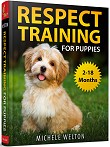Male Dogs versus Female Dogs: Which Makes a Better Pet?
By Michele Welton, Dog Trainer, Breed Selection Consultant, Author of 15 Dog Books

Should you get a male dog or a female dog?
Did you know that most experts in the dog world use the word dog for male dogs, and bitch for female dogs?
For example, I do that.... now. But many years ago, when I was just a teenager, a kennel manager instructed me to "Exercise the dogs for 10 minutes each."
Now there were eighteen dogs in the kennel building, so this chore took a few hours. Toward the end, I happened to walk past the kennel manager with a little sweetheart named Millie at the other end of my leash. Imagine my confusion when the kennel manager shouted, "I told you to exercise the DOGS!!! Millie is a BITCH!!"
So.... to eliminate any confusion with terms... should you get a boy dog or a girl dog?
 Speaking very generally about male dogs...
Speaking very generally about male dogs...
Males tend to be more stable in mood than females – less prone to emotional swings. An elderly gentleman said of his big male dog, "He's as reliable and predictable as rain in Seattle. Summer or winter, morning or night, I can always count on Ringo to act the same."
Many male dogs are bolder and more aggressive than females. For example, most police/military dogs are males.
And yet in some breeds, it's the female who tends to be a bit "sharper" while the males are described as "affectionate goofballs" or "big ol' softies."
 Male dogs have genitals that are easy to see, which makes some owners feel self-conscious. When you roll them over to rub their belly, there's "something in the way." Male dogs may become aroused and/or lick their private parts. Again, some owners find this embarrassing, especially when Grandma happens to be visiting.
Male dogs have genitals that are easy to see, which makes some owners feel self-conscious. When you roll them over to rub their belly, there's "something in the way." Male dogs may become aroused and/or lick their private parts. Again, some owners find this embarrassing, especially when Grandma happens to be visiting.
A male dog is either unneutered (also called intact) or neutered (also called castrated or de-sexed).
Neutering/castration is surgery that removes the testicles from the scrotum, so the dog can't breed or sire puppies.
See my advice on the pros and cons of neutering a male dog.
 Speaking very generally about female dogs...
Speaking very generally about female dogs...
Female dogs are more prone to mood swings. They can be sweet and loving when they're happy – but a bit on the sulky side when they really, really don't like something.
Now mind you, I'm a proud member of the fairer sex myself. But I must admit that female dogs are experts at giving you That Dirty Look when something isn't to their liking.
Female dogs are often less physical than males, less "in your face" than male dogs. Females are affectionate, absolutely, but often on their own terms. They may request petting, then assert their independence by walking away when they've had enough.
Female dogs are opinionated and often manipulative. If they don't want to do something, they may try to work their charming wiles with you. If that doesn't work, they may become passively resistant or slink around with their tail down and ears back. Or give you one of those patented "looks." Some owners find this exasperating, while others find it amusing.
A female is either unneutered (also called intact) or neutered (also called spayed or de-sexed).
Neutering/spaying means surgically removing the uterus and ovaries so the female can't have heat periods or become pregnant.
See my advice on the pros and cons of spaying a female dog.
Which sex is better for YOU?
When you start looking for a puppy, you'll find many breeders recommending males as better pets.
Well, not so fast. There's a practical reason for this – breeders want to keep more females (for breeding) than males, so they always have more male puppies to sell. It's in the breeder's best interest to persuade pet buyers that males make better pets.
There are some Special Circumstances that might point you in the direction of one sex or the other.
Consider your size preference.
If you're looking for a medium, large, or giant breed with a medium or high risk of aggression toward people and/or toward other dogs... a female is more likely to be a bit smaller and physically easier to handle.
Consider the other dogs in your household.
First, if your current dog has a high risk of aggression toward other dogs, I recommend that you stop right now.
I can't tell you how many owners have called me after bringing home a female Rottweiler when they already had a female Akita or Alaskan Malamute or American Bulldog. Then I'm called in six months later because the two females are at each other's throats and the household is in chaos.
Are you surprised that those two dogs are female, rather than male? Yes, males have more of a reputation for fighting with each other, and yet many male-on-male fights are more posturing, shoving, skirmishing, and a few bites at each other. Whereas for sheer ferocity, female-on-female battles can be the worst of all. They tear viciously at each other and they are slower to forgive or forget.
It isn't fair to your current high-aggression dog to upset his or her world by bringing home an "invader." More importantly, it isn't fair to a new dog to put him or her into a situation where fear, stress, or injury could easily occur. The moral is, keep a high-aggression dog as a single dog.
If your current dog isn't really aggressive, but is a bit on the jealous or pushy side, make sure your new dog is the opposite sex AND a breed with a LOW risk of aggression (like a Lab or Golden Retriever).
If your current dog is good with other dogs, make sure the new dog is a breed with a LOW (or maybe MEDIUM) risk of aggression. If it's MEDIUM, go with the opposite sex, to be safe. If it's LOW, either sex should work.
Remember that when you mix the sexes, you either need to neuter one or both dogs, or else you need to be very careful to keep the dogs apart when the female is in heat.
Consider other dogs in your neighborhood.
If your next-door neighbor has an aggressive dog, you may want to get the opposite sex to avoid fence-fighting.
If an aggressive dog roams loose in your area, and you're unable to get its irresponsible owner (or Animal Control) to stop it, again you might be wise to get a dog of the opposite sex, else your daily walks may become stressful.
Of course, Murphy's Law says that if you take great pains to do this, you might find that on the day you bring your puppy home, your neighbor's dog (or the bully who roams loose) will die and be replaced by a dog the same sex as yours!
My best-selling books – now available FREE on my website
 Respect Training For Puppies: 30 seconds to a calm, polite, well-behaved puppy is for puppies 2 to 18 months old. Your puppy will learn the 21 skills that all family dogs need to know. Click here to read for free.
Respect Training For Puppies: 30 seconds to a calm, polite, well-behaved puppy is for puppies 2 to 18 months old. Your puppy will learn the 21 skills that all family dogs need to know. Click here to read for free. Teach Your Dog 100 English Words is a unique Vocabulary and Respect Training Program that will teach your adult dog to listen to you and do what you say. Click here to read for free.
Teach Your Dog 100 English Words is a unique Vocabulary and Respect Training Program that will teach your adult dog to listen to you and do what you say. Click here to read for free. 11 Things You Must Do Right To Keep Your Dog Healthy and Happy helps your dog live a longer, healthier life. Get my honest advice about all 11 Things before you bring home your new puppy, because some mistakes with early health care cannot be undone. Click here to read for free.
11 Things You Must Do Right To Keep Your Dog Healthy and Happy helps your dog live a longer, healthier life. Get my honest advice about all 11 Things before you bring home your new puppy, because some mistakes with early health care cannot be undone. Click here to read for free.
